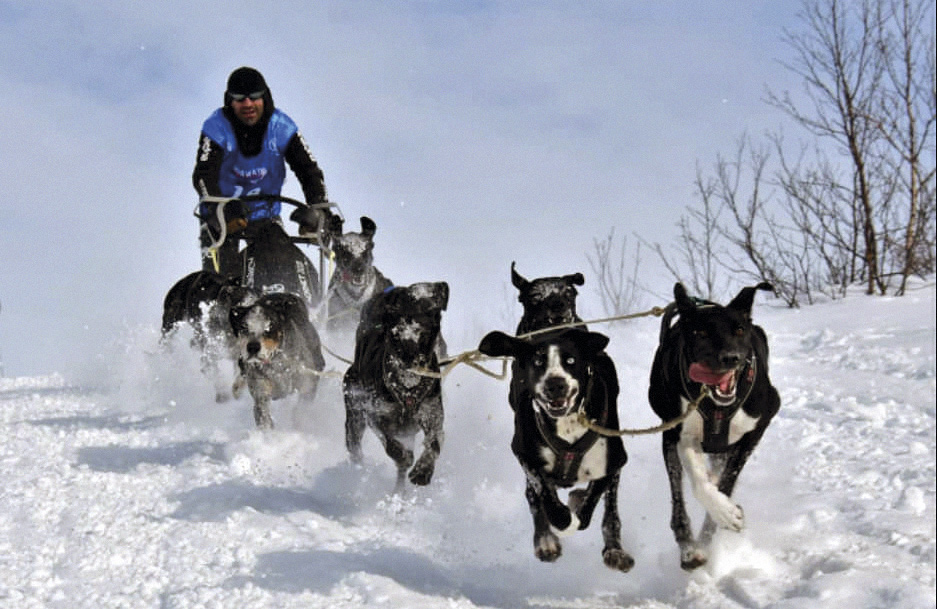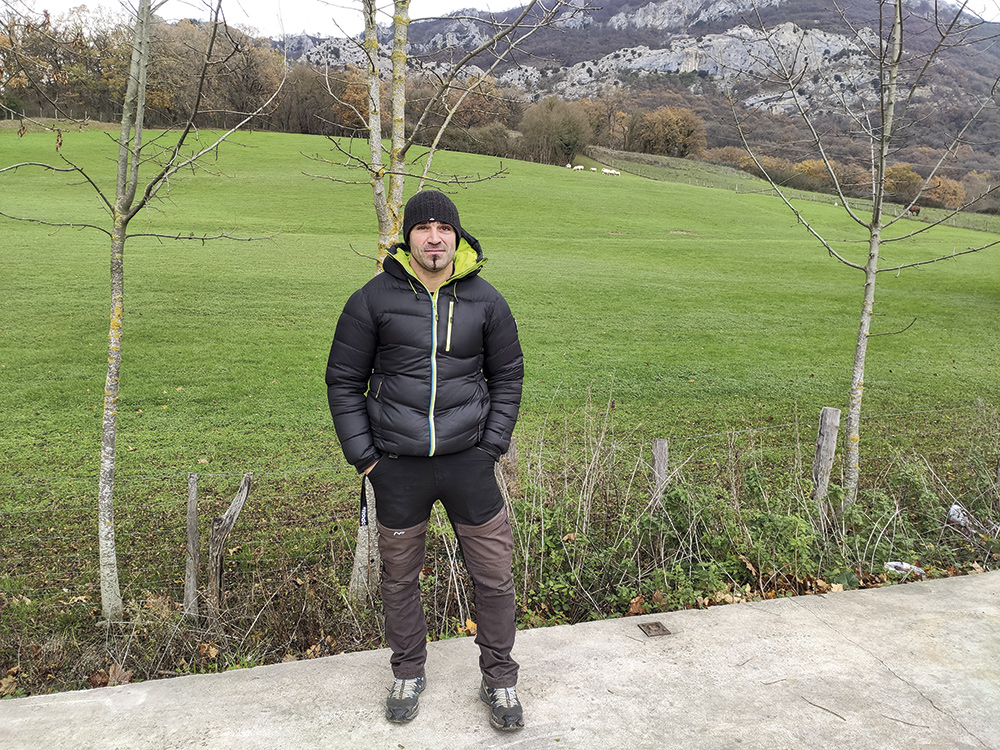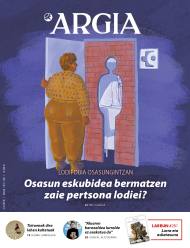"Musher can't see dogs as mere athletes, she must be her friend."
- Mushing was born as a means of transportation. This is called the mobility of dogs associated with sleigh. The inhabitants of the polar regions had a fundamental past and was widely used in the golden age of Alaska. Known worldwide in 1925, for five days they traveled 1,085 kilometers with sleigh dogs to bring medicine to the diphtheria population of Nome (Alaska). Since then, mushing has spread as a sport and has attracted many dogs and adventurers. One of them is Iker Ozkoidi (Pamplona, 1979). He started racing very young and has been twice as world champion. However, more than the results are the experiences lived with dogs.

When did he start to mushing and how did he know him?
I started about eleven years old, my father. There was no sleigh driver in Navarre. We were given a Malamute puppy to have it at home. One of our neighbors had a dog of the same breed, and when ours was two years old, his father decided to have a breeding. We stayed with all the children and at that time we knew this sport. We found it very striking and we cheered. We did things in our own way, taking as a reference what we saw in the magazines. A couple of years later, they started organizing the Pirena race in the Pyrenees. From abroad, experienced sleigh guides came and from them we learned the basics.
Strictly speaking, this sport consists of throwing the dogs out of a sledge. For you, what is mushing?
It's a way of life. It's more than having a lot of dogs and competing. I live outside the village on the mountain, and I have a big grass for dogs to run. Somehow, condition your life. Everything rotates around the dogs. You have to want to spend many hours with them. It doesn't stop you from living a normal life, but it's a long-time hobby and you have to live in a very favorable place: one thing is having one or two dogs and another 24, as in my case. In a city it's impossible.
What does this sport give you?
I like it. For example, I love climbing, but I can't compare what this sport gives me. It's terrible to be alone with dogs in a lost corner of the world. I really like to compete, but what I like most is training dogs. In competitions there's usually stress and nervousness, and you don't enjoy what's around you so much. You focus on everything related to the competition. However, in the workouts I stop from time to time, release the dogs and play with them. Training and feeding dogs well is very important, but the game also seems fundamental to me.
"A lot of people think dogs suffer. Well, if a dog doesn't want to run, there's nothing to do: he'll sit or lie down."
Your relationship with them will be as important as dogs being fit, right?
You can't see dogs as mere athletes. You have to be your friend. I always have freedom at home, and I dedicate myself every day to play with them and to do some caresses. You realize many things right now: the attitude of each one, if he has injuries… If you want to have a good mushe you have to love dogs.
How does such a large group of dogs govern?
With a lot of patience and love. I have dogs of all kinds: pups, young people, adults and retirees. When they are ten years old they cannot compete, according to the regulations.
In racing, how many dogs do you throw it away?
I now participate in mid-distance tests and in European and World championships you can compete with two, six or twelve dogs. I also compete for races of one or two weeks, where you can enroll twelve dogs. You must tie a minimum of six dogs to the snack. As there is a possibility of change, you manage the group: I usually use eight dogs, and so each day I go with four new ones.

How are workouts usually?
We must adapt to the climatic conditions here. From January to September I take them loose to the mountain, and I go by bike or by quad. These are walks rather than trainings. The goal is not to stand still. Real workouts start with the cold. This year, for example, we had to wait until November. We leave early in the morning and at first we go for a few kilometers. We work on forest tracks and we put together the quadera to work the muscles. I do the exercises on land until December, and then I go to Norway. Resistance and speed work in snow.
What is the work of the guide?
The main tasks are team management and dog support. On the flanks, for example, we have to climb the slopes of the ski resorts, where it is very important that the driver is fit: the more you run, the better the time you will get. In addition, care must be taken that dogs do not mix and sometimes at excessive speeds.
What characteristics do dogs have for this sport?
The most commonly used dogs are a cross between a Nordic breed and hunting dogs. Their resistance and speed are high and they work more easily than huskys, as they have no problems with livestock.
They can start competing from the year and a half. Do they have to be taught already?
It's better to teach it from a young age, yeah. All my dogs were born at home and at six or seven months I took them to the workouts. Adult dogs are tied to the flock and pups are loose. When you come back a year, I start tethering the quad. At first they do a kilometer. They learn quickly. If you wait until you're two, it's certainly not the same.
The championships are held from January to March. How often are they?
Sprint and half-distance are played in stages. It starts and ends in the same place. Some are two to three days, but others last ten or twelve days. Long-distance racing brings together two points. It must go through different checkpoints. Sprint tests usually run around 24 kilometres, in medium-distance tests between 30-60 and in long-distance tests over 70 kilometres. As for the duration, they can travel between 40 and 50 kilometers in two hours. Some races are real adventures, like in Odyssen, where nights spend making vivacs or in a tent. It's hard because you get defeated, but the experience is tremendous.
"Conditions are difficult because the winters are getting shorter and shorter. There should be more snow training places in the Pyrenees"
Isn't it an overeffort for dogs?
Many people think dogs suffer and we force them. Well, look, if a dog doesn't want to run, there's nothing to do: he'll sit or lie down. From Lera they enjoy a tremendous shot. When I take the harness, the face changes. They start to jump, to cheer with joy. In the attitude of dogs you see that it's something they really like. Not all races may be willing to travel as many miles, but they feel happy in workouts and careers. However, we attach great importance to managing efforts. If you're not used to touring miles, we don't exceed that limit in racing. I always take the conditions into account: if the runway is wrong, I do not follow. It's happened to me, I've gone first and I've left the race. The health of dogs is the most important thing.
They can compete for eight or nine years. And then what happens?
It's a big contrast, and if you stop training suddenly, there are dogs that age very quickly. I train them to stay active. Travel less kilometers and teach the youngest. In my house I have a large plot and they retire a lot.
What is the relationship between dogs like?
Maybe it's genetic, but I have no problem with my dogs. They carry chinchos. You should be careful when females are in heat because males get a little silly. In sleigh, females are faster and lighter. As a leader, I always use females. The leaders are two dogs that go ahead and are responsible, among other things, for marking speed and spinning. The males have more strength and I put them behind, closer to it, because they are the ones that have to do the most.
In Europe, it is impossible for mushing to be a profession, right?
Even if you're a sponsor, you don't win enough to live. He could have chosen fifteen years ago, because in some races he was given money as a prize. But now it's not possible. It's a rich sport that the poor do. In Germany there are many millionaires in the mushing. They have no more work to train and compete. That is unthinkable here. It is a very expensive sport, and if you want to do long training, you have to do long trips. It is a huge economic and temporary investment.
Has the mushing changed a lot since you started?
Yes, a lot. Notice, we made harnesses with tapes of blinds. Being wooden, the sledges were very rigid; it was like putting skates in a closet. Then came aluminum sledges and today there's also carbon. Dog feeding has also evolved a lot. Now we feed them as athletes.
What is the situation of this sport in Basque Country?
The number of people running, cyclists or skis with one or two dogs has increased considerably. But as far as the real mushing is concerned, today we are far less than before. The disappearance of Pirena causes damage. It competed close to home in the Pyrenees, and the atmosphere was immense.
Anyway, the best kiss is from here, you're the world champion.
It's amazing. It's taken me a lot to get to the top, and it's not easy to keep it there either. Let me see how things are going this year. It would be good to remain the best. I would also like to see this sport grow, even if it is difficult. It is a winter sport, and seeing that here the winters are getting shorter and shorter, conditions are not good. I think there should be more snow training places in the Pyrenees. Now we can only act at the Baqueira Beret ski resort and we only have permission for one track.
Alaska is the cradle of mushing. Have you never made an effort to go there?
There is another world; more than one championship is played every weekend and the prizes are immense. There you can live the mushing. I once went there, looking for a place to live and a job, but it wasn't possible. I haven't been competing yet. I used to be my obsession, but I see it difficult, at least in the short term. Carrying all the dogs is very expensive and you have to go a month earlier for the dogs to adapt. Accommodation and transport costs should therefore be increased. But, well, it will come.
You're still on time. Some are still driving at age 80.
This sport is good, it is not old. Moreover, people are the ones who best practice in the last years of their career. The experience helps a lot and, of course, once you retire, you have more free time. Now I have to juggle to have enough time to train. Yes, no sacrifice anything important to be able to play the mushing, if not, I leave it. I have often had doubts, because this sport is nothing thankful. For example, the death of dogs is very hard. I give them a very good life and they die because they are old, but I suffer a lot. However, I intend to continue in action. I don't know if I'm going to last until I'm 80, but I really enjoy this sport.
ZAUN-ZAUNK
A dog,
a unique friend? A dog will never turn your back.
What does a dog need to be happy? Treat it
with respect and feel loved.
In
general, do people treat
them well? Some, thinking they're OK, educate them badly. Dogs are not people.
Many
dogs live in weights today. What do you think? I think that is
fine. If you take them out into the street every day, there should be no problems.
What is the main virtue
of dogs? Clear loyalty.
Do you do a
lot in your rías? Sometimes yes, with so many dogs you have to set limits. You have to teach them that you're the leader.
How do you communicate with
them? We have such a close relationship that I often don't need words to give orders. They do things on their own.
It's been a few weeks since the red-white collective madness and, yes, I know, besides not being last minute, many of us are fed up with it. Today I have the date of writing this article and I am from the tobacco world wanting to write, scream, vomit (that or explode!) What about... [+]













